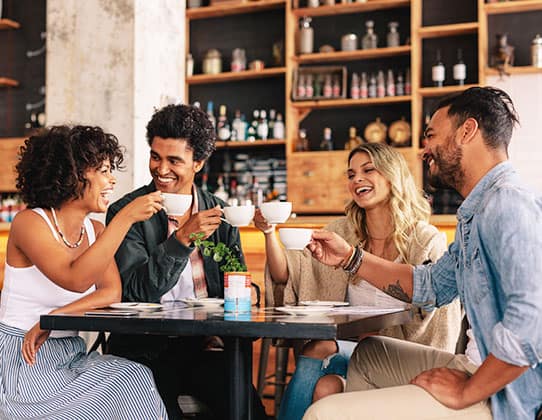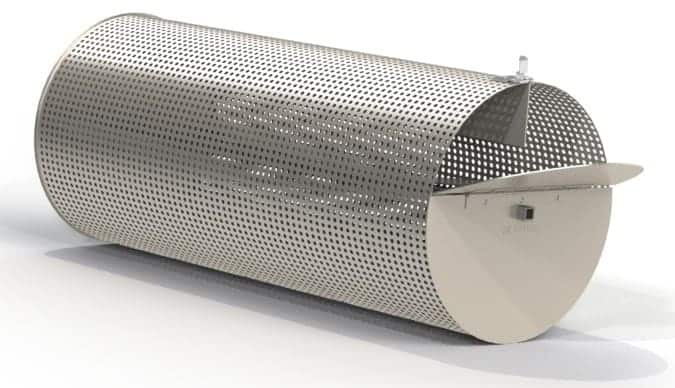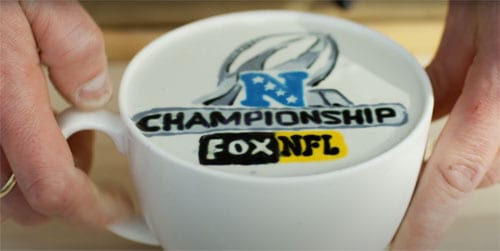
If you should experience lack of uniformity or mixed dark and light coffee upon finishing a roast, please apply the following tips in order. It just happens that the most common culprit for uneven roasts is also the easiest to fix. Work through these solutions step-by-step in order to fix this issue. Almost every case of uneven roast has been solved with the below methods.
Please apply these points in order as the first suggestions will be the most likely and easiest solutions.
- Leveling the Drum: Keep in mind, that your drum must be level when roasting. Use a level to see that the drum is completely level to the gravity. This will prevent coffee from piling up more in one end than the other. If this happens then you will get a larger bean mass on one side vs. the other and that heavier side will roast slower than the lighter side. This will cause unevenness. Try this as a first approach. Please use an actual bubble level sitting directly on top of the drum.
- Keep in mind that just because you may have leveled the drum on your first initial setup, if you roll your grill to a different location, the ground may now be unlevel compared to your first original location. Some people have spray-painted the ground (or otherwise marked) to help them remember the exact roast location where it was level.
- “An unlevel drum got me personally not long ago, I started to do a demo roast for a local Atlanta customer, rolled the grill out to a random spot on the pavement and fired it up. Then first started blending with second, or at least I thought, nothing was making sense at all and it finally occurred to me, I was totally roasting on a hill. I wrote these articles, and I should know better than anyone, and I just ruined 10LB of coffee. “Eh, we’ll mix it and grind it and call it a blend!”
To clarify this issue, let me give you an analogy. Imagine a glass cylinder, half filled with water. Now turn it on the side, the same way as a drum would be positioned. The way it would roll off a table. Now, tilt it at 10 degrees, right or left. Doesn’t matter which way. So now you will have a little bit what resembles a swimming pool with a deep end and a shallow end. That’s exactly what happens to the coffee in a drum on an incline, or with an unlevel drum. You end up having a shallow end of coffee and a deeper end. That shallow end will roast faster, and the deeper end will roast slower.
As the roast progresses, the shallow end enters first crack because it is thin and small massed, and gets more direct heat exposure, and then as the roast progresses it works it’s way cracking from the shallow end to the deep end. But since there is relatively a short time between 1st and 2nd crack, then by the time the deep end starts on it’s way through 1st, the shallow end is well finished with 1st and begins into 2nd, and then the process repeats with 2nd crack having the 2nd crack roll slowly from the shallow end to the deep end.
So the end result is this really confusing mess where 1st blends in with 2nd and the crack seems to go on for a strangely long time and the end result will be dark beans mixed with light beans and if you wait until the deep end finishes the 2nd crack, then by that time, the shallow end is well on it’s way to becoming charcoal. The greater the angle the more pronounced this effect will be. Thus the importance of leveling the drum.
- Heat or Rotational Speed: Another reason that could explain uneven roasts is rotational speed. If you are roasting at less than 6RPM’s you will probably get uneven roasts. The closer your approach to 20-60 RPM’s the more even your roasts will be. The coffee just doesn’t get mixed well below 6RPM and doesn’t get evenly tossed around. A bit like rolling a ball of dough, the inside of the dough ball never makes it around to the outside where the heat is. Finally you may not be roasting hot enough. If you have done all these things and still getting uneven roasts, you may not be getting enough heat penetration. Try increasing your heat by 25 degrees and see how the roast turns out.
- A Good Thermometer-“But my built-in thermometer is just so pretty in my grill!”: Please do not underestimate the necessity of a good quality thermometer. I would actually prefer you roast with NO thermometer than a built-in one. In so many cases that I have seen, even on $400-$700 grills, the thermometer is horribly inaccurate. Maybe fine for chicken, but not fine for coffee roasting as we need good temperature control. These thermometers cannot even be depended upon to be accurately inaccurate. On many cases I have seen, people will roast thinking that they are at, say, 500 degrees F only to finish their roast late, and realize that they were not hot enough. Except then on Roast #2, after bumping up the temp to say 525 to compensate, find that they are even longer on their roast time.
It just makes no sense. What in reality happened here, was that on roast #1, the temperature indicated 500 but was really at 450. On roast #2, even though our roaster bumps the temperature to 525 to compensate for the late roast, in reality the temperature this time wasn’t 50 degrees to low, but now 75 degree too low or worse, and thus was roasting at 425F. All this is to say, that if you use the built in thermometer, you have a good chance of chasing a ghost and will end up frustrated in the end. You won’t know how much you are off, or if you are off at all until you get a good one to compare to. I love the Tel-Tru brands of thermometers, but any quality thermometer will do. I’ve seen supposedly high dollar thermocouples be off as well, so just so you know. Roasting at the wrong temperature can also then be a cause for uneven roasts.
- Burner Balancing: Burner balancing is more necessary on the larger 8LB and 12Lb drums. In some grills you may have difficulty, particularly with the 8LB Drum and 12Lb Drum and very minimally present on the 6LB Drum with uneven roasts. This has nothing to do with the drum and everything to do with the way grills are constructed. This is a result of trying to roast coffee evenly over an 18″ or 24″ span over multiple and varying heat sources. Specifically, your burners may not be distributing heat evenly across the entire length of the drum. This is particularly present on 8LB Drums and 12Lb Drums (Long drums) and on grills that don’t have adequate burner diffusion.
To clarify, off of each burner you have a column of heat rising up off of the burner directly, which is controlled by your burner knob. It can be difficult to tell exactly how hot that flame is. Just because your knob on burner 1 is set to 75% and burner 2 is set to 75% and burner 3 is set to 75% does NOT mean that each burner is actually producing the same amount of heat. The valves in the burner knobs on these grills are just not manufactured with fine tolerances, and may have slightly different gas flows depending on their internal structure. Furthermore, your burners themselves may have slightly differing hole sizes which translates to more or less gas getting through and thus more or less heat.
The longer a drum gets, the more pronounced this becomes as you are stretching the coffee out over 24″ (in the case of the 8LB/12LB) and it is quite easy to get the right side feeling hotter then the left (or vice versa) , or to have cold spots here or there (relatively speaking). This is almost invisible in the 4LB 12″ drum as the coffee is compacted into such a compact area.
So, to solve this, some experimentation and trial and error is necessary. The objective we are trying to achieve here is to even out the heat that the drum “feels” across its entire length.
So how can we even out the heat? Here are a few approaches. Adjust your burners up or down to achieve equal heating on all burners. This is a bit tricky and may involve some raw roast time. You may notice that coffee in one end of the drum is darker than the other. This should indicate to you that burners on that side are running a hair too high. They can only be 10 degrees off and that 10 degree difference over a 20 minute roast can cause the coffee on one side to be predominantly darker to give an example. So backing that burner down to a lower setting for the entire roast may be a solution. I have seen some people getting to know their grill so well, they know what each burner needs to be set at to get an even roast. An infrared thermometer may help here. You can take the laser pointer of the infrared thermometer and hold it on the bottom of the drum to see what areas of the drum are hotter than others and then adjust it accordingly.
I’ve also seen some individuals install thermometers, one relatively over each burner to see what each burner was doing so they could adjust things in real time.
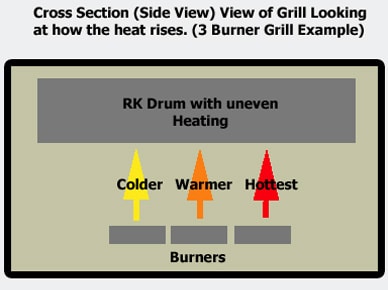
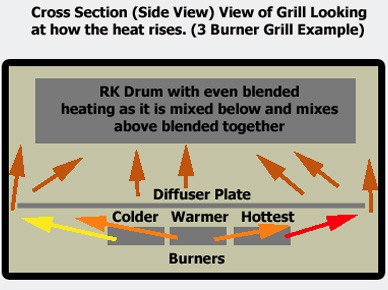
-
Burner Diffusion: Another approach and possibly a better approach in my opinion is simply to diffuse or blend the heat coming from all the burners into one heat source. The basic way to do this is to install a piece of metal over the burners. It is true that most grills do indeed come with a heat diffuser over the burners. However, if you look at some of these diffusers (particularly in grills whose burners run front to back) you will see that the diffuser only covers the burner tube itself in a sort of upside down “V” profile and then allows the heat to boil straight up. You can see that this really does very little to break up that heat column coming up off of the burner. The idea here is to keep the drum from feeling the direct heat off the burner and blend all the heat together. Some grills have a great diffuser plate which rather covers the majority of the bottom of the grill thereby blending the heat very well. Some of the new infrared grills are better at this as they use an entire plate to actually separate the heat column from the coffee. (Be careful to watch BTU requirements on the infrared grills).
So what you need to do is look at your diffuser and decide if the diffuser is doing a good job of breaking up and blending the heat rising off the burners. If not, throw out the diffuser you have and install a piece of aluminum or steel. Usually 1/16″ steel works well. The piece should be big enough to fit in the entire bottom of the grill leaving only 1 and 1/2″ of clearance between the edge of the plate and the wall of the grill on all sides. So what we want is for the burners to heat the plate, and then for the plate to radiate heat towards your coffee and secondly for the heat to collect under the plate and then boil up around the edges of the plate to fill the space in the grill where the drum sits. (So you should have heat rising up around the edges of your square plate on all four sides of the rectangular plate). Some people have drilled holes in this plate to allow for more heat to trickle up through the holes. Lastly, please understand that your heat up and cool down timeframes will be extended as the majority of your heat will go towards heating the plate initially extending your heat up time, but conversely the plate will hold heat between roasts reducing your heat up time for roast #2. Remember steel retains heat longer than aluminum so keep that in mind. It doesn’t matter either way however. See the two images for further clarification
-
Larger Coffee Volume: The thought is terrifying to some, as any mistakes may result in ruining larger and larger amounts of coffee, but filling the drum up more may stabilize the roast a bit. Once you’ve evened things out above as much as possible, a fully loaded or 75% loaded drum may give you a fairly solid consistent bean mass that may hold so much heat that it roasts itself within it’s own mass more evenly. As a result you may find that larger roasts just by nature roast more evenly as they bathe in their own heat. Think of it this way If you have a block of steel the size of a die/dice (Like the dice you play monopoly board game with right?) If you heat that little cube up to 500 degrees, and then set it out in the air, how long will it hold heat? Doesn’t exactly matter but you and I would say it might cool down to ambient temperature within 5 minutes? More importantly, looking at the dice with infrared, you would see that the edges of that little cube would cool very quickly followed by the center of the cube cooling off. Now as a comparison. Take the same little dice cube and grow it to the size of your car. Huge right? 20 feet long or better. Massive steel cube. Heat that thing up to 500 degrees. In comparison, that thing would stay hot probably all day and maybe all night till the next day because it has so much mass and it would bleed off heat very slowly. Looking at that in infrared, the surfaces might get slightly cooler (but still warmer overall than the small cube, as the center keeps the outside hot) but as the center cools it bleeds heat to the outside, and overall that center is going to stay at 500F for quite a long time, and the edges much hotter in comparison as the heat from the center bleeds out.
The same idea applies to our coffee mass, the larger the mass, the more that hot center holds heat and bleeds it’s heat to the surrounding beans on the outside, each bean keeping the next bean warm and so forth. The larger the mass, the more even the heating because the large mass holds the heat better than a small mass.
Not that it doesn’t happen with a small 1LB mass, it’s just much less noticeable and pronounced and occurs at a much faster/less effective rate.
- Cold Spots – At this point, we’re getting down to some hair splitting, and I don’t ever recall solving uneven roasts with this one, but we’ll throw it in as a last resort. Probably we’re not going to get much further but it may be worth noting to see if your grill has any relative cold spots. By this I mean, areas of the drum that are not sitting over a burner (generally speaking) or holes in your grill that are allowing too much ambient air through. Don’t rule out wind coming through the back of the grill or rotisserie slots. Some people roast in strong wind and while it doesn’t really affect the roast much, it can cause a temperature difference in some grills. Think about the draftiness of your grill and then either shield/block the holes or roast out of the wind.
These approaches, have solved 99% of uneven roast issues. If you’ve thoroughly looked at all of the above solutions and are still having issues, please give us an email or a call and we can step through things together. Thanks

